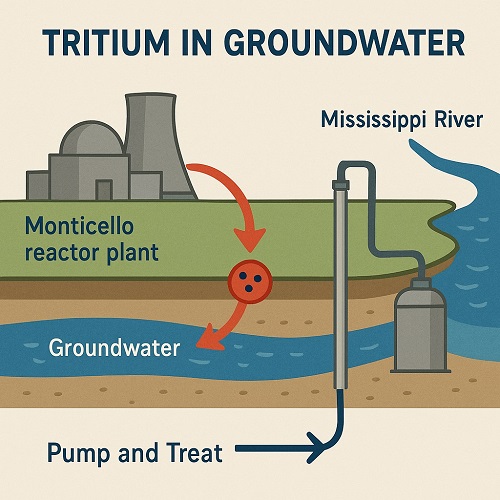Tritium in the groundwater?
Hey Dr. Z – I live in Minnesota, near the Monticello reactor plant. I heard in the news that they found tritium in the groundwater near the plant. Do I need to be worried? Should I start buying bottled water? Appreciate any info you can provide – and thanks!
So…let’s start with is where tritium comes from and how it can affect our health – then we’ll get into whether or not it might be putting your health at risk.
Production of tritium
Nuclear fission produces a LOT of neutrons, and some of those neutrons are absorbed by hydrogen atoms in the water used to keep the reactors cool. When a hydrogen atom (H) captures a neutron it turns into deuterium (D or H2); deuterium is identical to hydrogen in chemical reactions so it can form molecules of water with deuterium instead of hydrogen – HDO and HD2. Deuterium can also capture neutrons to form tritium (T or 3H), which is radioactive. And, for what it’s worth, there’s a huge amount of tritium produced naturally on Earth due to cosmic ray interactions in the atmosphere. Tritium emits a very low-energy beta particle with a half-life of about 12 ¼ years.
Health effects of tritium
Tritium emits a weak beta particle with an energy of no more than 18 thousand electron volts (keV). Because of this, the US EPA will permit up to 20,000 pCi of tritium in each liter of drinking water (1 pCi is one trillionth of a Curie), meaning that a person who drank only water with that level of tritium contamination would receive a radiation dose or only about 4 mrem each year. Since tritium is just like hydrogen and will go anywhere in the body (all of our cells use water), tritium ingestion results in radiation exposure to the whole body and not to any specific internal organ. Ingesting tritium can cause health problems – but it takes a LOT more tritium to cause problems than most would expect. That’s why the EPA limit is so high. Incidentally, I should also mention that ground water frequently contains naturally occurring tritium, formed by cosmic ray interactions in the atmosphere. So the idea of ingesting tritium in our drinking water isn’t really the issue – it’s the amount of tritium and its source that people are worried about.
What happened and what’s being done at Monticello
Somewhere near a million gallons of water leaked from the plant into the local environment. To address this, Monticello has been pumping and treating groundwater for years, trying to reduce tritium concentrations to the lowest levels they can achieve and storing the water in temporary holding tanks. Monticello has reported that their sampling shows that tritium concentrations in the Mississippi River have not increased and that groundwater near the plant has tritium concentrations lower than the maximum allowable levels in all but a few monitoring wells, and that those are the ones closest to the reactor plant. Monticello has been pumping groundwater and treating it to remove tritium since the leak was first discovered.
“Pump and treat” is a widely used remediation methodology for groundwater contamination. The general principle is to place wells into the contaminated aquifer, to pump water out of the aquifer and treat it to remove the radioactive contamination, and to inject the treated groundwater back into the ground to dilute the remaining contamination.
Do you need to worry?
Not really – for a few reasons.
First, most of the contamination appears to be contained on the Monticello site and, as long as it remains onsite, it can’t affect drinking water anywhere else.
Second, tritium is about as innocuous as you can get for a radionuclide – it emits only a very low-energy beta particle that can’t travel very far in tissue and, in addition, tritium doesn’t concentrate in any particular organ which means that the dose from tritium is spread throughout the entire body instead of concentrating in a specific organ.
Third, the EPA limit is based on the assumption that the only thing that people drink is the contaminated water – but that’s not the way that most people drink. If you enjoy a few beers in the evening, if you eat at a restaurant from time to time, if you drink from a water fountain at work, or anything else along those lines then the already-low 4 mrem annually will be reduced to even lower levels.
Fourth – even though it’s possible that some tritium made its way into the Mississippi, the Mississippi is a big river that’s going to dilute the tritium to levels that are almost undetectable, and that are certainly far lower than the amount in the groundwater. I know that “dilution is not the solution,” but in this case, there is so much more water going down the Mississippi that even a million gallons of tritiated leakage will be diluted far beyond the point of being able to cause harm from swimming in, drinking from, or eating fish from the river.
To summarize
Passing water through a nuclear reactor will produce tritium when the hydrogen in the water captures a few neutrons from fission. This water is normally stored but, at Monticello, it leaked into the local groundwater, originally at levels in excess of EPA limits. However, the contamination seems to have remained onsite, where it’s unlikely to enter the local water supply. But even if it does, tritium is not a very potent radionuclide and it seems unlikely that anyone will be able to ingest enough to cause any health problems. In other words, this is a big regulatory problem that isn’t likely to cause anyone harm.
